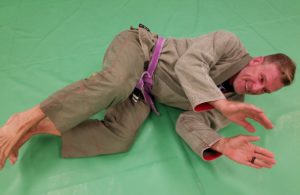The Savage Kitten
-by: Daniel Frank
One of the most common questions that I am frequently asked during private lessons, in group classes, or while teaching seminars is, “How do I escape from side control?” And, despite it being commonly asked by white belts, the question arises throughout the ranks of jiu jitsu. My simple answer to the question has always been: the Savage Kitten.
What is the Savage Kitten? Well, the best way to understand the position is by watching a group of kittens play fighting with each other. The kitten on the bottom of the scrap will always retreat onto its side, with its arms and legs tucked in close to its body, protecting its soft belly. The savage kitten position in jiu jitsu has the practitioner doing their best impersonation of that kitten. The savage portion of the moniker is added because, it seems, that most jiu jitsu practitioners and academies throughout the world feel obligated to present a persona of toughness. There are countless logos of jiu jitsu academies featuring muscle-bound sharks, growling bull dogs , or raging gorillas. This position follows their lead because it just wouldn’t be the same if it were named the dainty, cute kitten position.
 Why is the savage kitten position important for your game? When you begin your jiu jitsu career you tend to get crushed under side control. You seemingly spend a majority of your rolls with another person laying horizontally atop you, crushing your head with an effective cross-face. The savage kitten is a way to stop this from occurring with regularity. In order to use it effectively the practitioner needs a realistic understanding of when their guard is working and when it is all about to fall to pieces. When you realize that your guard is about to be demolished, you need to maneuver your body into the savage kitten position by lying on your side, facing your opponent. Now, protect your head by cupping your head and using your forearm as a frame. You can grab your opponent’s bicep, rather than cupping your head, if it is more comfortable for you. Bring your bottom knee up and make a connection with your elbow. By doing so you have made a solid frame with your forearm and your shin thereby protecting your belly from attack. Once you are in a safe position then you can move ahead. The most important aspect of the savage kitten position is that you have enabled an easier transition to the next position rather than getting stuck in a no-win situation where you are at the mercy of your opponent.
Why is the savage kitten position important for your game? When you begin your jiu jitsu career you tend to get crushed under side control. You seemingly spend a majority of your rolls with another person laying horizontally atop you, crushing your head with an effective cross-face. The savage kitten is a way to stop this from occurring with regularity. In order to use it effectively the practitioner needs a realistic understanding of when their guard is working and when it is all about to fall to pieces. When you realize that your guard is about to be demolished, you need to maneuver your body into the savage kitten position by lying on your side, facing your opponent. Now, protect your head by cupping your head and using your forearm as a frame. You can grab your opponent’s bicep, rather than cupping your head, if it is more comfortable for you. Bring your bottom knee up and make a connection with your elbow. By doing so you have made a solid frame with your forearm and your shin thereby protecting your belly from attack. Once you are in a safe position then you can move ahead. The most important aspect of the savage kitten position is that you have enabled an easier transition to the next position rather than getting stuck in a no-win situation where you are at the mercy of your opponent.
Now that you have established a solid savage kitten position, what can you do with it? You can get back to your safe place. Be careful not to attempt too much with this new maneuver. A rolling reverse omoplata sounds fantastic, but impractical, and will probably result in you getting crushed under side control with a shoulder grinding into your face. Use the savage kitten position to stay safe, create space, and recover your guard. Once your guard is established your jiu jitsu life becomes a lot easier.
 Now that you have learned the savage kitten position you will need to put it into action. Look at your academy as your laboratory. You have countless opportunities to practice and to perfect your techniques. Whenever you roll, and are playing guard, continue to do an internal systems check on your guard at all times. The moment that you realize that it is all falling apart rely on your savage kitten to get you back in the fight. Once you can rely on this position to keep you safe, and prevent you from spending each roll getting crushed, then you are free to practice all of the more exciting and entertaining techniques that jiu jitsu has to offer.
Now that you have learned the savage kitten position you will need to put it into action. Look at your academy as your laboratory. You have countless opportunities to practice and to perfect your techniques. Whenever you roll, and are playing guard, continue to do an internal systems check on your guard at all times. The moment that you realize that it is all falling apart rely on your savage kitten to get you back in the fight. Once you can rely on this position to keep you safe, and prevent you from spending each roll getting crushed, then you are free to practice all of the more exciting and entertaining techniques that jiu jitsu has to offer.